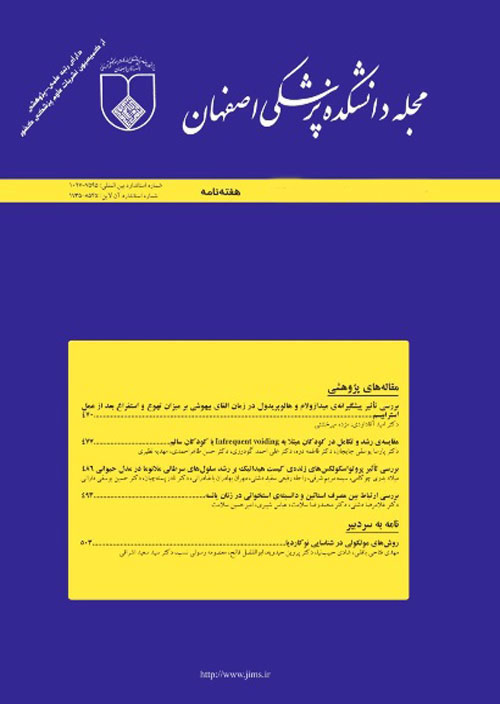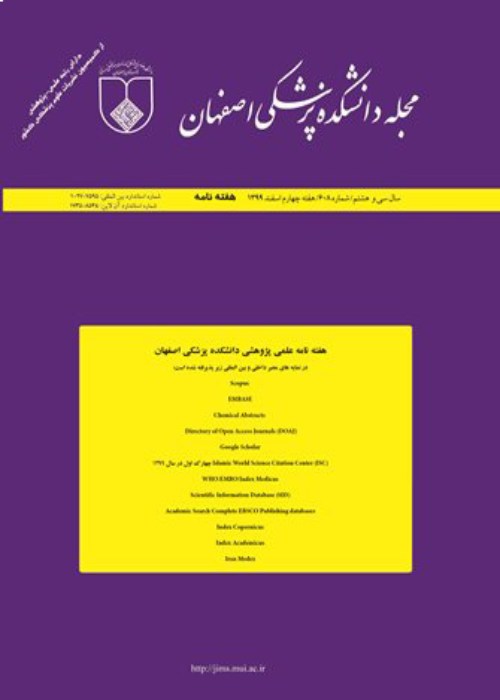فهرست مطالب

مجله دانشکده پزشکی اصفهان
پیاپی 619 (هفته سوم خرداد 1400)
- تاریخ انتشار: 1400/03/17
- تعداد عناوین: 3
-
-
صفحات 212-218
مقدمه فیبروز کبدی، اغلب به فعال شدن سلول های ستاره ای کبد (Hepatic stellate cells یا HSCs) و تشکیل بیش از حد زخم در کبد نسبت داده می شود؛ چرا که این سلول ها باعث تولید بیش از حد ماتریکس خارج سلولی می شوند. مراحل پیشرفته ی این بیماری، اغلب منجر به سیروز کبد و سرطان کبد می شود. این مطالعه با هدف بررسی نقش کلسترول بر فعال سازی سلول های ستاره ای کبد انجام شد.
روش هاسلول ها در محیط کشت Dulbecco's Modification of Eagle’s Medium (DMEM) همراه با 10 درصد از Fetal bovine serum (FBS) کشت داده شدند و با غلطت های 25، 50، 75 و 100 میکرومولار از کلسترول به مدت 24 ساعت تیمار شدند. سپس، میزان بیان ژن های Transforming growth factor beta (TGF-β) و Collagen1α و نیز سطح پروتئین Smad3C برای ارزیابی فیبروزکبدی مورد سنجش قرار گرفت.
یافته هامیزان بیان ژن های TGF-β و Collagen1α در غلظت های 75 و 100 میکرومولار کلسترول نسبت به گروه شاهد به صورت معنی داری افزایش یافت. همچنین، سطح پروتئین Smad3C پس از گذشت 2 ساعت از تیمار سلول ها با غلظت 100 میکرومولار کلسترول، نسبت به گروه شاهد به صورت معنی داری افزایش یافت.
نتیجه گیریکلسترول با افزایش سطح پروتئین Smad3C و فعال کردن مسیر سیگنالینگ TGF-β باعث افزایش پروتئین های اصلی درگیر در تولید ماتریکس خارج سلولی از جمله Collagen1α می شود. در نتیجه، کلسترول می تواند زمینه ی پیشرفت فیبروز کبدی را فراهم کند.
کلیدواژگان: فیبروز کبدی، کلسترول، beta factor growth T -
صفحات 219-226مقدمه
خدمات فوریت های پزشکی (Emergency medical services یا EMS) در درمان بیماران مسموم با مواد اوپیوییدی نقش مهمی دارند. تجویز صحیح نالوکسان در این بیماران، یک اقدام نجات بخش می باشد. از این رو، مطالعه ی حاضر با هدف مقایسه ی همبستگی بین نالوکسان تجویز شده توسط اورژانس شهر و اورژانس مسمومین در بیماران مسموم با اوپیوییدها انجام گرفت.
روش هادر این مطالعه ی مقطعی، بیماران مسموم با اوپیوییدها ارجاع شده توسط EMS به بخش مسمومین بیمارستان خورشید اصفهان از فروردین 1397 تا اسفند 1398 از نظر عوامل توکسیکو اپیدمیولوژیک و پیایند مورد بررسی قرار گرفتند.
یافته هااز 340 بیمار مورد بررسی، 80 درصد مرد بودند. 3/33 درصد موارد، مسمومیت با متادون و 2/23 درصد موارد، مسمومیت با تریاک بود. 9/47 درصد از بیماران پس از تجویز نالوکسان توسط EMS دچار خواب آلودگی، 9/35 درصد از آنان با هوشیاری کامل و 5/3 درصد دچار بی قراری بودند. اختلاف معنی داری در میزان اشباع اکسیژن خون بین دو گروه دریافت و عدم دریافت نالوکسان توسط EMS مشاهده گردید (020/0 = P). میانگین سنی بیماران دریافت کننده ی نالوکسان توسط EMS و اورژانس بیمارستان بیشتر از بیماران بدون دریافت نالوکسان بود. همبستگی قوی بین تزریق نالوکسان توسط EMS با تزریق نالوکسان در اورژانس بیمارستان وجود داشت (001/0 > P، 77/0 = r). نوع ماده ی مخدر (تریاک) و سن بیمار (بیشتر از 40 سال) پیش گویی کننده ی تجویز نالوکسان توسط EMS و اورژانس بیمارستان بود. همه ی بیماران بهبودی یافتند.
نتیجه گیریهمبستگی قوی در خصوص تجویز نالوکسان بین EMS و پزشک اورژانس مسمومین وجود داشت. با توجه به میانگین بالای سن بیماران دریافت کننده ی نالوکسان، لزوم توجه بیشتر جهت پیش گیری از عوارض احتمالی نالوکسان توصیه می گردد.
کلیدواژگان: نالوکسان، مخدر، مسمومیت، اورژانس پیش بیمارستانی، آنتاگونیست مخدرها -
صفحات 227-233
مقدمه:
بیماری های قلبی مادرزادی، از شایع ترین ناهنجاری های مادرزادی می باشد. موفقیت در تشخیص به موقع بیماری های قلبی مادرزادی شدید با استفاده از فن آوری پالس اکسی متری، تا حدود زیادی بستگی به آگاه بودن پزشکان در معاینات بدو تولد نوزادان دارد. این مطالعه، با هدف بررسی میزان آگاهی پزشکان از غربالگری نوزادان به وسیله ی پالس اکسی متری به منظور تشخیص زود هنگام بیماری های قلبی مادرزادی شدید در شهر اصفهان انجام شد.
روش هادر یک مطالعه ی توصیفی- تحلیلی به صورت مقطعی در سال 1398، 65 نفر از پزشکان شرکت کننده در جلسه ی برگزار شده توسط مرکز آموزش مداوم دانشگاه علوم پزشکی اصفهان مورد بررسی قرار گرفتند. ابزار جمع آوری داده ها، پرسش نامه ی محقق ساخته بود که روایی و پایایی آن مورد تایید قرار گرفت. واکاوی آماری داده ها با استفاده از نرم افزار SPSS انجام شد.
یافته هااز مجموع پزشکان شرکت کننده در مطالعه، 51 نفر (5/78 درصد) متخصص کودکان بودند. میزان آگاهی بیشتر پزشکان از غربالگری نوزادان در بدو تولد به وسیله ی پالس اکسی متری در سطح متوسط (2/49 درصد) ارزیابی شد. نتایج آزمون Line regression نشان داد که فقط محل کار پزشکان (بیمارستان و یا مطب) با آگاهی آن ها از غربالگری نوزادان در بدو تولد به وسیله ی پالس اکسی متری ارتباط معنی داری داشت (010/0 = P، 31/0- = β). در کل، این متغیر 7 درصد از تغییرات میزان آگاهی پزشکان را پیش بینی می کند.
نتیجه گیریپزشکان به ویژه متخصصین کودکان به عنوان خط اول ارایه ی خدمات سلامت به نوزادان در بدو تولد، نیاز به آگاهی بیشتری در زمینه ی غربالگری نوزادان به وسیله ی پالس اکسی متری جهت تشخیص و ارجاع به موقع موارد مبتلا به بیماری های قلبی مادرزادی دارند.
کلیدواژگان: آگاهی، تشخیص زودرس، پالساکسیمتری، بیماریهای قلبی مادرزادی
-
Pages 212-218Background
Hepatic fibrosis is often attributed to activation of hepatic stellate cells (HSCs) and excessive scar formation in the liver. Because these cells overproduce extracellular matrix, the advanced stages of the disease often lead to liver cirrhosis and hepatocellular carcinoma. In this study, the role of cholesterol in the activation of hepatic stellate cells was investigated.
MethodsCells were cultured in Dulbecco's modification of Eagle’s medium (DMEM) with 10% Fetal Bovine Serum (FBS), and treated with 25, 50, 75, and 100 μM cholesterol concentrations for 24 hours. Then, gene expression transforming growth factor beta (TGF-β) and collagen1α, as well as Smad3C protein level were measured to assess liver fibrosis.
FindingsThe expression of TGF-β and collagen1α genes increased significantly compared to the control group at 75 and 100 μM cholesterol concentrations. In addition, Smad3C protein level increased significantly compared to the control group after 4 hours of cell treatment with a concentration of 100 μM cholesterol.
ConclusionCholesterol increases the major proteins involved in the production of extracellular matrix, including collagen1α, by increasing the level of the Smad3C protein and activating the TGF-β signaling pathway. As a result, cholesterol can lead to the development of liver fibrosis.
Keywords: Liver fibrosis, Cholesterol, Transforming growth factor beta -
Pages 219-226Background
Emergency Medical Service (EMS) has an important role in the management of patients with opioid poisoning. Proper administration of naloxone is life-saving in these patients. We performed a study to compare the correlation between naloxone prescribed by the EMS and poisoning emergency physician in hospital for patients with opioid poisoning.
MethodsPatients with opioid poisoning referred by EMS to the poisoning emergency room of Khorshid Hospital affiliated to Isfahan University of Medical Sciences, Iran, from April 2016 to March 2017 were evaluated for toxico-epidemiological factors and outcome.
FindingsOut of 340 patients studied, 80% were men. Poisoning with methadone (33.3%) and opium (23.2%) were the most opioid poisoning. 47.9% of patients were drowsy after administration of naloxone by EMS, 35.9% were fully conscious, and 3.5% were restless. There was a significant difference in blood oxygen saturation between the two groups receiving and not receiving naloxone by EMS (P = 0.02). The mean age of patients receiving naloxone by EMS and hospital emergency service was higher than patients not receiving naloxone. There was a strong correlation between naloxone administration by EMS and in the hospital (r = 0.77; P < 0.001). Kind of opioid (opium) and patient’s age (more than 40 years) predicted the naloxone administration by EMS and in the hospital. All patients recovered completely.
ConclusionThere was a strong correlation in naloxone administration between EMS and emergency service in hospital. Due to the high average age of patients receiving naloxone, more attention to prevent possible side effects of naloxone is recommended.
Keywords: Poisoning, Emergency medical service, Naloxone, Opioid, Narcotic antagonists -
Pages 227-233Background
Congenital heart diseases (CHDs) are the most common type of birth defect. Success in the early detection of critical congenital heart diseases (CCHDs) using pulse oximetry technology depends on a large extent on physicians’ awareness of neonatal clinical examinations. The aim of this study was to investigate physicians’ awareness of newborn pulse oximetry screening for early detection of CCHD in Isfahan City, Iran.
MethodsA total of 65 physicians participating in the meeting at the continuing education programs at Isfahan University of Medical Sciences were enrolled in this descriptive-analytical, cross-sectional study in 2019-2020. Data were collected by a questionnaire, developed by the researchers, which validity and reliability were confirmed. Data analysis was conducted using SPSS software.
FindingOf physicians participated to this study, 51 were pediatricians (78.5%). The most physicians (49.2%) had a moderate level of awareness of neonatal screening at birth by pulse oximetry. The results of linear regression analysis showed that only the doctors' workplace (hospital or office) was significantly associated with their awareness of neonatal screening at birth by pulse oximetry (P = 0.01, β = -0.31). In total, 7% of the variations in physicians’ awareness about neonatal screening at birth by pulse oximetry were predicted by this variable.
ConclusionPhysicians, particularly pediatricians, as the first line of health care providers to the newborns at birth, need more knowledge about the neonatal pulse oximetry screening, for early detection and referral of neonates with CHDs.
Keywords: Awareness, Early diagnosis, Pulse oximetry, Congenital heart defect


